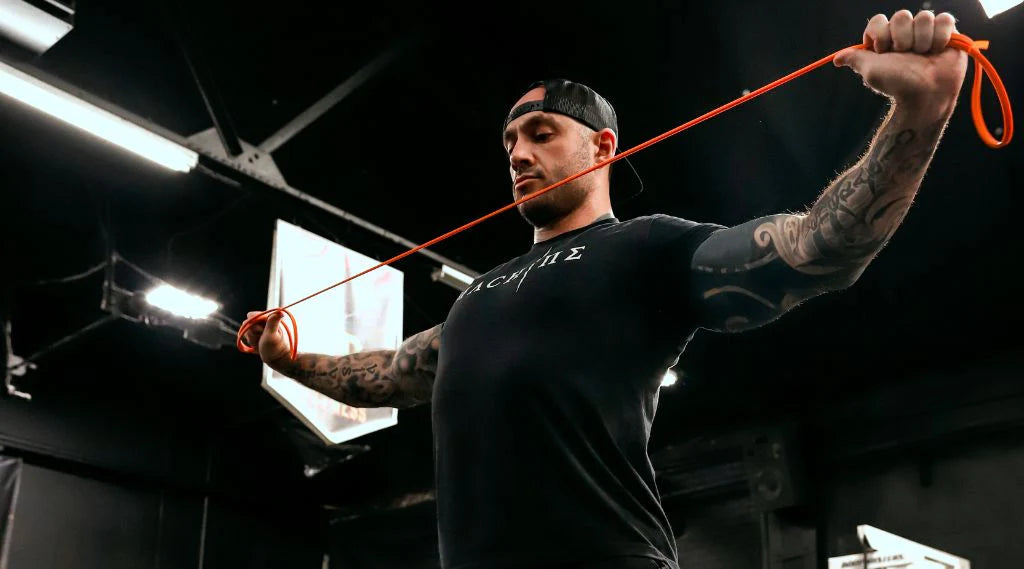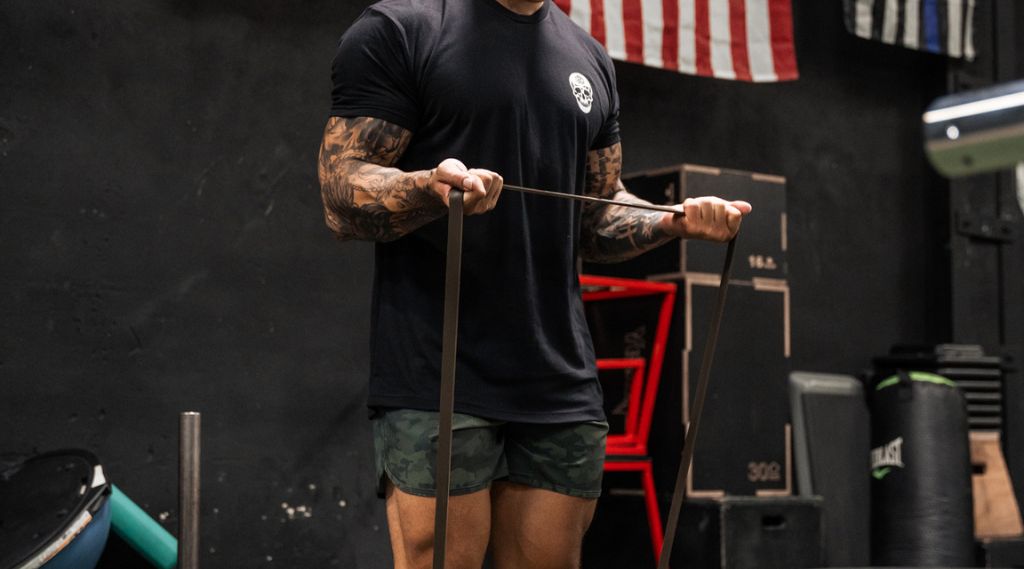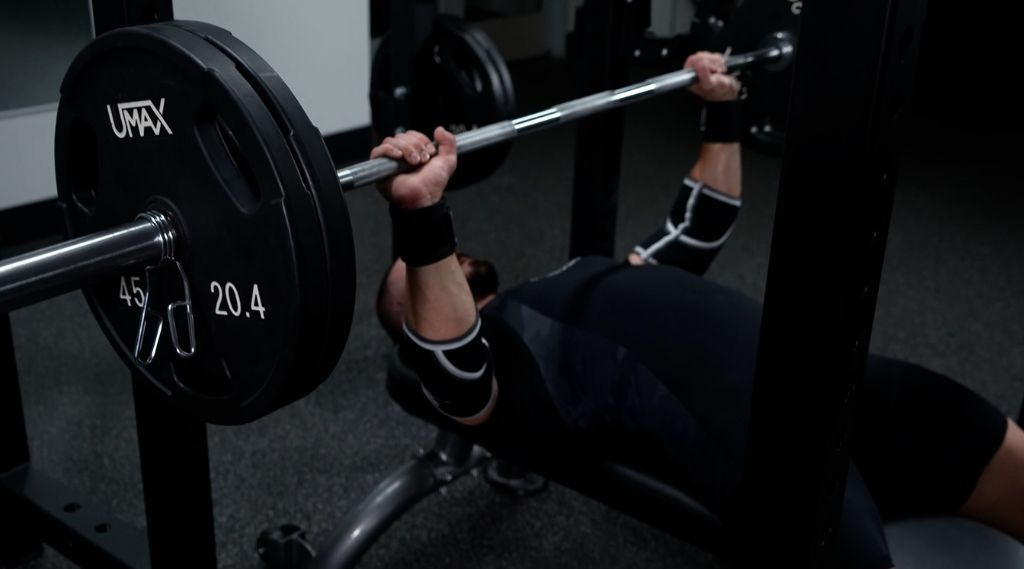As a strength coach, I’ve noticed that many lifters struggle to perform band pull-aparts properly and incorporate them effectively into their training program.
Resistance band pull-aparts are an effective exercise for targeting the muscles in the upper back and shoulders. Band pull-aparts can be used to warm up for other strength movements or they can be incorporated as an accessory movement to improve shoulder stability, build a stronger back, and encourage better posture.
In this article I’ll explain the proper technique for performing band pull-aparts, common mistakes to avoid, and how to incorporate them into your training program to ensure you get the most out of the exercise.
Key Takeaways
- Progress the resistance of your band every 1-4 weeks if using band pull-aparts as an accessory movement, but keep the level of resistance constant if using them as a warmup.
- Band pull-aparts are often performed incorrectly by allowing the shoulders to round forwards, having the shoulders shrugged, using too much momentum, or choosing the wrong resistance.
Muscles Worked With Band Pull-Aparts
Band pull-aparts primarily target the muscles of the upper back, specifically the rhomboids, rear deltoids, and middle traps. Additionally, the exercise engages the muscles of the shoulders, including the rotator cuff muscles, as well as the biceps, triceps, and forearm muscles.
Band pull-aparts engage many muscles of the upper body, making them the perfect addition to an upper body warm-up routine.
Band pull-aparts are great for encouraging shoulder stability in pressing movements like the bench press, and proper scapular retraction for stronger contractions in pulling exercises like barbell rows.
How to Do Band Pull-Aparts Properly
To perform band pull-aparts properly follow these steps:
- Begin by standing tall with your feet shoulder-width apart and holding a resistance band in front of you with a grip slightly wider than shoulder-width.
- Keep your arms mostly straight with just a tiny bend in the elbows. Ensure your elbows are pointed outwards.
- Pull the band apart horizontally until the band comes into contact with your chest and your hands are in-line with your body. Squeeze your shoulder blades together as you pull the band apart.
- Pause for a brief moment, focusing on the contraction in your upper back, and then slowly return to the starting position.
- Repeat the movement for the desired number of repetitions, maintaining control throughout the exercise.
Related Articles:
Common Band Pull-Apart Mistakes (& How To Fix Them)

Now that you understand how to perform the movement, it’s important to understand what mistakes to watch out for.
Mistake #1: Using Excessive Momentum
One common mistake is using excessive momentum to complete the movement. This takes the focus away from the targeted muscles and reduces the effectiveness of the exercise.
This can be a result of attempting to perform the movement too fast or trying to use too heavy of a resistance band.
Using too much momentum looks like swinging back and forth or simply not taking the time to pause and control arms.
Fix: Focus on Control
To avoid using excessive momentum, slow down the movement and concentrate on squeezing your shoulder blades together. This will ensure that you are engaging the proper muscles throughout the exercise.
Thinking about tempo can help manage this control. Pull the bands apart slowly over the course of 1-2 seconds then follow that up with a one to two second pause while squeezing your shoulder blades together. End with a 3-4 second eccentric slowly bringing the bands together without allowing the band to lose tension fully.
Mistake #2: Rounded Shoulders
Allowing your shoulders to round forward during band pull-aparts places unnecessary stress on the shoulders that can lead to shoulder impingement. Rounded shoulders also limit the activation of the back muscles.
Performing the band pull-apart with improper technique encourages improper technique in movements to follow, like the bench press and pulling motions, because the proper muscles are not being primed correctly.
Fix: Maintain Proper Posture
Keep your chest up, shoulders back and down, and core engaged. This will help prevent rounded shoulders and maintain a neutral spine.
Rounding of the shoulders can often come from excessive shrugging of the shoulders as you pull the band apart. To fix this, make a point to pull your shoulders down away from your ears as you pull.
As you get to the end range of the motion, your shoulder blades should be able to squeeze together like you are pinching someone’s hand with your shoulder blades.
Mistake #3: Using The Wrong Resistance
Using a band that does not provide enough resistance can limit the challenge and hinder progress. Oppositely, using a band that is too heavy limits the range of motion and your ability to contract the right muscles.
When it comes to warming up, sometimes choosing a lighter band isn’t the worst thing as long as you have enough tension to feel the target back muscles and get them warmed up.
However, if using this as an accessory movement to build up the upper back muscles a heavier band (but not too heavy) will be needed.
Fix: Choose the Right Band
Select a resistance band that provides enough tension to challenge your muscles without compromising form, then gradually progress to heavier bands as you get stronger.
The band you choose will be different depending on if you are warming up or doing band pull-aparts as an accessory movement.
For a warm up, most people use a lighter band (20-35lbs), like the Desert Tan Band in the Gymreapers Military Set.
For an accessory movement, the band you will use will depend on your strength in the movement; some people may stick to a lighter band, while others may need a slightly heavier band (30-85lbs).
Related Articles:
- The Proper Way To Do Banded Pull-ups
- The Proper Way To Do Banded Upright Row
- The Proper Way To Do Lateral Raises With Bands
- The Proper Way To Do Inverted Rows With Bands
Implementing Band Pull-Aparts Into Your Training Routine
Band pull-aparts can be a useful warmup or accessory exercise. Which purpose you are using it for will determine how to best use it.
To incorporate band pull-aparts into your training routine, consider the following guidelines:
Sets and Repetitions
For accessories perform 2-4 sets of 8-15 repetitions. As you become more proficient, you can increase the number of sets or repetitions to continue challenging your muscles.
For warmups perform 2-3 sets of 20 or more repetitions. There is no need to increase the number of sets and reps that you perform as this is not to challenge you, it’s to get your muscles warm through increased blood flow.
Load/Resistance
For accessories, choose a resistance that is challenging by the last repetition (3RIR** or less). As weeks go on you will want to overload the movement by increasing the load you are using to allow for growth and strengthening of the target muscles.
You can increase the resistance by using a heavier band or using the same band but pulling the band tighter in the start position to increase the tension.
For Warm-ups, choose a resistance that is not challenging (10RIR or more) to get blood into the muscle, without being overly taxing.
**RIR** (Reps In Reserve): Refers to how many more reps you would have been able to perform before complete exhaustion. For example, 3RIR means you could have done 3 more reps.
Frequency
For accessories, aim to perform band pull-aparts 1-3 times per week. Allow at least one day of rest between sessions to allow for recovery. If you’re incorporating them multiple times a week, try varying rep ranges to work on strength (<12 reps) as well as endurance (12+ reps) of the target muscles by varying the load.
For Warm-ups, perform band pull-aparts on any and all of your workouts. They are particularly useful as a warmup on any bench press or upper body focused days. However, they do help warm up the upper back muscles which many find useful for heavy squat and deadlift workouts as well.
Exercise Order
For accessories, include band pull-aparts near to the end of your workout.
Generally in a workout, you want to include your heavier compound movements (Ie. Bench press or shoulder press) earlier in your workout when you have less build up fatigue then follow them up with your more isolated movements like band pull-aparts.
The exception to this is in some styles of bodybuilding training you will perform pre-exhaustion training where you will work your target muscle group to near failure with an isolated movement and then hit your larger compound after when the muscle is already tired (i.e. Band pull-aparts followed by barbell rows).
For Warm-ups, it is beneficial to include band pull-aparts toward the beginning of your workout when your muscles are cold and need to get the blood flowing to feel warm and ready.
Studies have found that dynamic warm ups such as the use of band pull-aparts decrease injury risk and improve performance.
Variations
Here are some variations of the band pull-apart you can use for accessories or warm-ups to target different muscles with the same bands.
Band Pull- Aparts Overhead
The overhead pull-apart is the same concept as the conventional band pull-apart but is designed to target the lower trap muscles by starting with the band overhead and pulling it apart to finish behind your neck.
Band Pull-Apart Tricep Extensions
Use this variation to target your triceps by starting in a similar starting position to the band pull apart but with your elbows straight out from the shoulder joint. Keeping everything from the elbow to the shoulder fixed push your wrists out by extending the elbow.
Band Back and Forths
Start in the same position as the band pull-apart with your arms straight out in front of you. Place a little tension into the band then rotate the band overhead and behind your back. Return to the starting position and repeat.
*Note if this causes any excessive discomfort then consult a physiotherapist.*
Complete Banded Warm-up Routine
Here’s how I recommend implementing band pull-aparts into your warm-up for bench press, pulling movements, or heavy squats and deadlifts:
3 Rounds/Sets (No rest between)
- 20 Band Pull- Aparts
- 20 Band Pull-Aparts Overhead
- 20 Band Pull-Aparts Tricep Extension
- 5 Band Back and Forths
Best Bands for Band Pull-Aparts

GymReapers’ bands are made from premium latex and are available in various resistance levels, allowing you to choose the ideal band for your strength and fitness goals and are made to last.
My top recommendation is the Military Resistance Band Set because it comes in a variety of resistance options to accommodate anything from the lightest of warmups to building the strongest of backs.











Hinterlasse einen Kommentar
Alle Kommentare werden vor der Veröffentlichung geprüft.
Diese Website ist durch hCaptcha geschützt und es gelten die allgemeinen Geschäftsbedingungen und Datenschutzbestimmungen von hCaptcha.